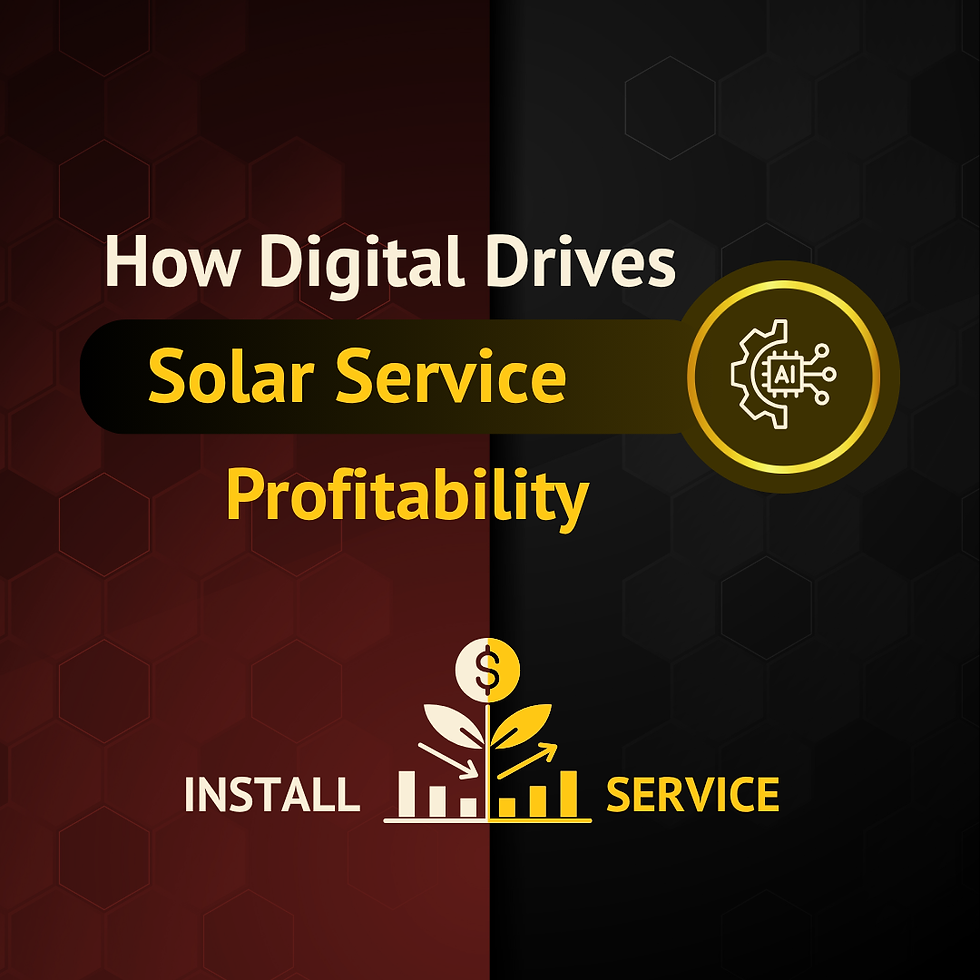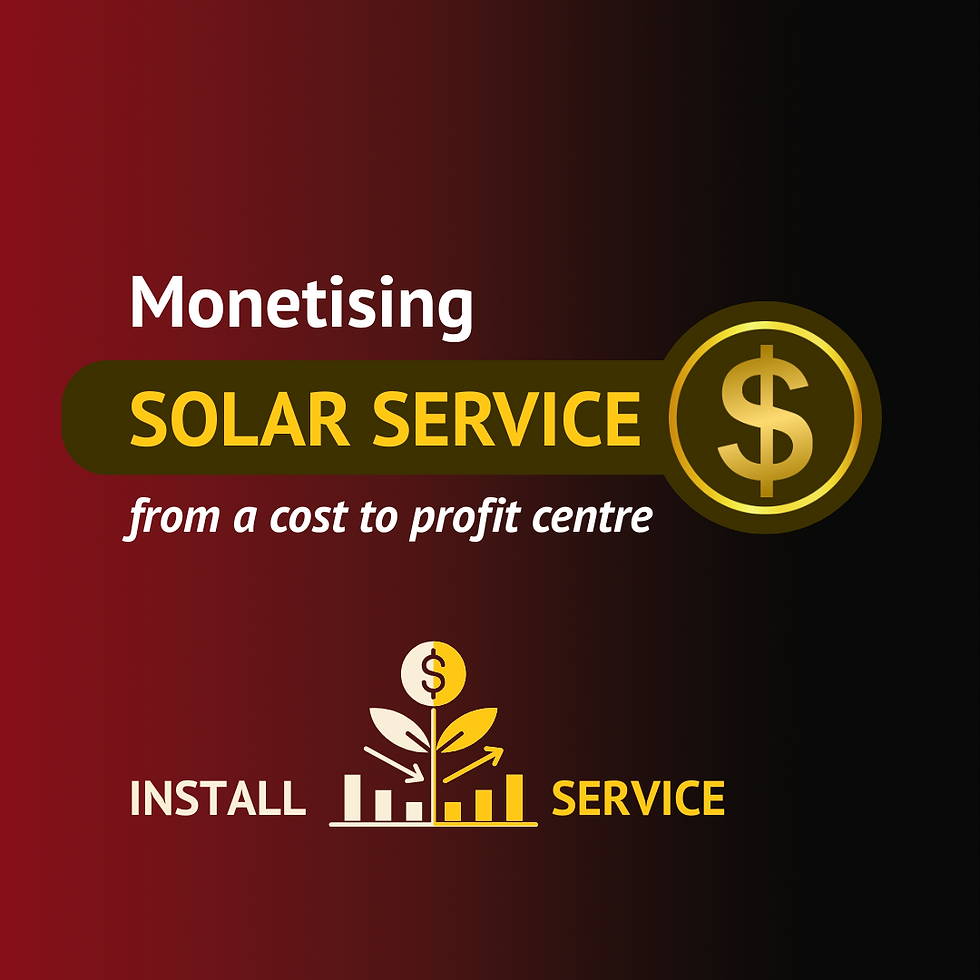Service-Centric Solar — Part 1: Installation Is a Sprint, but Service Wins the Marathon
- SIVA HARSH S
- Jul 16
- 7 min read
Updated: Aug 8
About this series: This blog launches a three-part series for rooftop PV installers. Solar Service is transforming from a back-office cost centre into the primary engine for profitability, customer loyalty, and sustainable growth. For installers navigating this new reality, building a robust, technology-enabled service division is no longer optional – it is an imperative for survival and leadership. The businesses that thrive will be those that stop thinking like PV retailers and start thinking like energy service providers, capturing value over the 25+ year asset lifecycle instead of just the 25-day installation cycle.
We’ll unpack why after-sales excellence has become the industry’s real profit engine, show how to monetise O&M, and reveal the digital playbook that lets small teams care for thousands of assets without ballooning headcount.
Series Roadmap | What you’ll learn |
Part 1 — The Turning Point: Why Build a Service Business Now? | How market upheaval (examples from Australia and North America) makes service capability a differentiator and a strategic advantage |
Price bands for maintenance contracts, orphan-fleet rescue checklists, and a P&L that proves service beats hardware margin. | |
Choosing a monitoring and analytics stack, enforcing mobile checklists and using AI to slash truck-rolls and warranty risk. |

1. A Tale of Two Markets — Same Strategic Conclusion
The global rooftop solar industry is at a critical inflection point, while two of its most mature markets, Australia and the United States, appear to be moving in opposite directions.
Australia is experiencing a sustained solar boom. The nation surpassed 4.1 million small-scale solar installations in late 2024 and continues to add impressive capacity, with 235 MW of new rooftop PV installed in May 2025 alone. This growth is being supercharged by the federal government's "Cheaper Home Batteries Program," which launched on July 1, 2025, and offers a significant rebate on the upfront cost of home battery systems. The impact is already clear: battery attachment rates are soaring, with 28.4% of all new PV installations in the latter half of 2024 including a battery.
Across the Pacific, the United States residential solar market is facing a harsh reality. In 2024, residential installations plummeted by 31%, a downturn fuelled by high interest rates and disruptive policy changes like California's NEM 3.0, which drastically reduced the value of net metering. The situation was further exacerbated in mid-2025 with the enactment of the "One Big Beautiful Bill Act," which accelerated the phase-out of the 30% federal solar tax credit. This has led to a wave of over 100 installer bankruptcies, a contraction of the industry on a scale never seen before and over a million orphan systems.
Yet, despite these divergent paths—one of accelerating complexity, the other of painful contraction—the strategic imperative for installers in both markets has converged on a single point: the future is service. Whether your challenge is managing the technical demands of a solar-plus-storage fleet in a booming hyper-competitive market or finding stable revenue when new sales are slow, the answer is the same. The long-term money has migrated from the one-time markup on panels to the lifetime management of performance.
2. When Hardware Profit Evaporates
For years, the solar industry thrived on a simple formula: falling hardware costs drove demand, and installers profited from the markup on panels and inverters. That era is definitively over. A global oversupply of PV modules has led to a collapse in panel prices, with some markets seeing prices fall below $0.15/W. This, along with price competition, is great for consumers, but has stripped the profit from hardware sales for installers.
The Installers can no longer rely on hardware markups to sustain their business. The value has migrated downstream to the long-term servicing of the solar asset and monetising the existing relationships for repeat sales or referrals.
3. The Orphan-Fleet Land-Grab
The market turmoil, particularly in the U.S., has created a new and rapidly growing challenge: the "orphan" solar fleet. With over 100 installer bankruptcies, over a million orphan solar systems have no one to support them. These are not dead systems; their manufacturer warranties are often still intact, but the crucial link for service and maintenance is gone. Even in Australia, the orphan systems count is estimated at over 250,000 and is growing.
This crisis for solar plant owners represents a golden opportunity for savvy, service-oriented installers. These "solar orphans" are seeking reliable professionals to take over the care of their systems. They are often less price-sensitive than new buyers, with their primary concern being the protection of their investment. For a service-ready installer, every orphan represents a golden opportunity:
A paid diagnostic and repair, often at a premium rate.
An easy and grateful customer for a recurring Annual Maintenance Contract (AMC).
A powerful source of referrals, born from the trust you build by rescuing their investment.
This is a once-in-a-generation market opening. Early movers who build a rapid, professional orphan-intake workflow are locking in hundreds of new service contracts per month before large, national aggregators can mobilise. This has created a new market segment, with companies like Omnidian in the U.S. and solar marketplaces in Europe looking to service these orphaned fleets. Installers who can build the capability to diagnose, repair, and maintain these systems can rapidly grow their service business and build a loyal customer base.
4. Service Economics in Plain Numbers
The financial argument for a service-centric model is compelling. While hardware margins have shrunk, a well-priced service offering such as proactive monitoring coupled with an annual maintenance contract (AMCs) can deliver gross margins of 40% or even higher.
Furthermore, the economics of customer loyalty are undeniable. Research from Harvard Business Review shows that acquiring a new customer can be 5 to 25 times more expensive than retaining an existing one. A Gallup analysis found that engaged customers are 23% more likely to spend more and are a powerful source of low-cost referrals. By focusing on service, installers can create a "service flywheel" where happy customers lead to more business, fuelling a virtuous cycle of growth and profitability. To build this flywheel, installers must re-engineer their economics around two core principles: customer lifetime value and recurring revenue streams. More on the economics in Part 2 of this blog series.
5. Why You Shouldn’t Miss Out on the Golden Years
As the O&M market grows, third-party aggregators are emerging to offer outsourced service solutions. While tempting, handing over your service operations means giving away your most valuable assets:
The Customer Relationship: The trust you build through excellent service is what drives referrals and repeat business.
Margin Control: While outsourcing may seem easier, you'll be sacrificing the high margins that come with a well-run in-house service division.
Keeping O&M in-house with required processes and digitisation in place ensures that you retain control over the customer relationship and capture the full lifetime value of every system you install.
6. Batteries: Complexity You Can Monetise
The rise of home battery storage is a key catalyst for the shift to a service-centric model. A solar-plus-storage system is exponentially more complex than a standalone PV array. It's an active, software-driven asset that requires ongoing management of its state of charge, depth of discharge, and thermal conditions. This complexity introduces a host of potential failure points that homeowners are not equipped to handle, creating a clear need for professional O&M
Beyond basic maintenance, batteries unlock a range of new, monetisable services:
Virtual Power Plant (VPP) Management: Aggregating home batteries to provide grid services can create a new revenue stream for both the homeowner and the installer
Advanced Energy Optimisation: Offering a premium service that uses software to optimise a customer's battery for time-of-use rates and self-consumption can provide significant value
Battery Health Monitoring: Providing regular reports on a battery's state of health and managing warranty claims can be a valuable, fee-based service
7. Check Your Pulse — Three Quick Questions
How ready is your business for the service-centric future? Ask yourself these three questions:
Visibility: Can you, right now, identify every system in your fleet that is underperforming by more than 30%?
Engagement: How many of your customers from 2022 have received a performance report or a tip on how to optimise their savings this quarter, or are proactively returning for a storage quote?
Revenue Mix: What percentage of your income for the next year is already secured through recurring service contracts?
If the answers to these questions are not readily available, it's a sign that it's time to start building your service capabilities.
8. The Time to Act Is Now
The last decade rewarded installers who could efficiently put panels on roofs. The next decade will reward those who can expertly protect, optimise, and monetise the megawatts already in the field.
The convergence of market forces has created a unique window of opportunity in 2025. The collapse in hardware margins makes a new revenue source essential. The explosion of orphaned systems has created a ready-made market of customers in need. The battery boom provides a compelling, complex product that demands professional service.
Installers who act now and begin building a robust service engine will secure a powerful, sustainable competitive advantage. You will build recurring, inflation-resistant cash flow, create a data moat your competitors cannot breach, and construct a business model that investors and financiers value at a premium.
Start today—before someone else signs your customers’ maintenance contract.
What’s Next in This Series
Part 2 – Monetising O&M: We’ll dive into the practicalities of pricing your service offerings, creating a playbook for rescuing orphan systems, and building a profitable service division.
Part 3 – The Digital Playbook: We’ll explore the digital tools and workflows that can help you scale your service operations efficiently, from integrated monitoring platforms to AI-powered fault prediction.
Stay tuned for the next instalment, where we'll show you how to turn the ideas in this blog into a bankable, profitable reality.
Navigating the solar market requires the right tools and insights. SolYield Software empowers solar professionals to automate operations, maximise customer satisfaction, and grow their business profitably with confidence. If you’d like to learn more or schedule a demo, contact us @ info@solyield.com



Comments